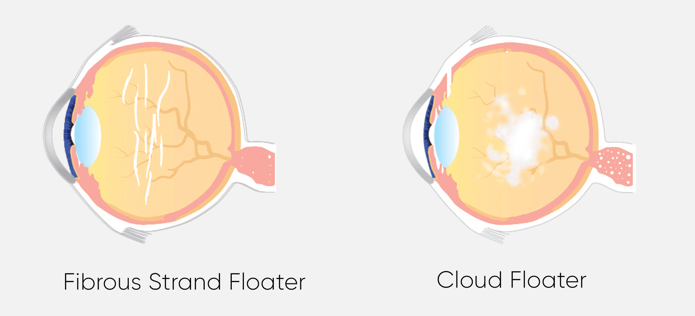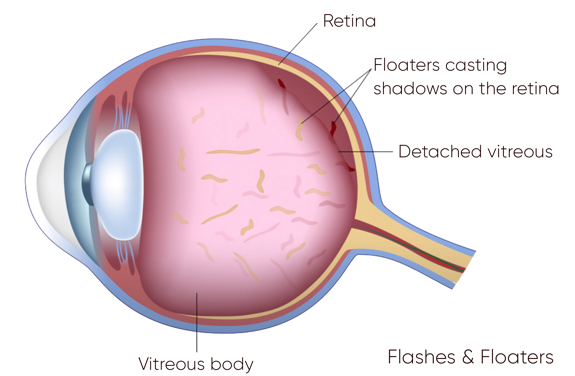Floaters
Are you seeing objects flying around in your vision? They may be inside your eye!
Many of us get floaters at some point in our life. For most, it happens later in life. However, for people that are very nearsighted, had surgery or trauma, and sometimes for no reason at all, they can occur at younger ages.
Floaters are caused by opacities in the vitreous. Usually, the vitreous is fairly clear. The vitreous is the jelly-filled cavity between the natural lens and the retina.
The objects in the vitreous cast a moving shadow over the retina as the eye moves. The vitreous is usually clear and fills the eye. As we get older, it shrinks just like Jell-O- that you made and forgot about in the back of the refrigerator. In the eye, the vitreous pulls away from the sides. The solid jelly is then floating around in liquid jelly therefore, sometimes the edges of the jelly are seen as a shadow.
New floaters are a good reason to get your eyes checked. An ophthalmologist should make sure there are no retinal tears, macular holes or vitreous hemorrhages. Those could be signs of a potential problem. Most people won’t have something needing treatment. However, but it’s impossible to find the ones that do without doing an exam.
What Can Be Done About Chronic Floaters? Laser vs. Surgery
The good news is for most people with floaters, the floaters get usually better over a period of four months. Almost 98% of patients with floaters are not bothered by them in four months. Most of them aren’t bothered after two months. For the two percent that are bothered, there are options. You don’t have to live with them.
3 Options for Bothersome Floaters:- Do Nothing. Just live with the floaters.
- YAG Laser Vitreolysis
- Vitrectomy
YAG Laser for Floaters (Vitreolysis)
A laser can be used to vaporize the floaters in the eye. A common misperception is that the laser breaks the floaters apart. It doesn’t. It’s remarkably safe with minimal serious side effects. It is very effective with almost 60% of people happy after only one treatment. It may take more treatments (though rarely more than two, in my experience) to get patients a happy endpoint.
It is important to note that you don’t have to get rid of every single floater to make someone happy. You just have to reduce it by 80% – 90% or take away the floaters that are in the mainline of sight. The biggest downfall is that it’s best for distinct vitreous opacities that are few in number. It’s not great nor practical for large cloud or cotton candy-type floaters with lots and lots of debris.

Vitrectomy: Vitrectomy is a surgery that removes the jelly from the eye along with all of the things that cloud it.
It’s generally not recommended for young people because cataracts almost always form afterward; and although the risks of other problems are small, they can be severe. For people that have already had cataract surgery, pars plana vitrectomy is a really safe option for removing the vitreous clouding. The safest way is just to get in and out and remove the jelly if there is no other retinal pathology. Long-term follow-up is necessary to monitor for retinal detachment and cystoid macular edema. These are more common in nearsighted or formerly nearsighted individuals or smokers. Vitrectomy may not be a good idea if the risk of macular degeneration is high. This is because some of the medicines used for wet macular degeneration don’t last that long without vitreous. For the majority, the risk is low 2-3% for serious complications. Vitrectomy for floaters is done in our state-of-the-art Same Day Surgery Center and usually takes 10 minutes or so.
At The Eye Clinic of Florida, we do both procedures. We have over 17 years of experience with YAG laser for floaters. Read some of our reviews here.
We also do floater only vitrectomies for patients that have had cataract surgery previously. We refer to our favorite retina specialists if patients have not had lens surgery or have other retinal pathology like an epiretinal membrane.
For anyone who may have eye surgery, we recommend taking Lutein 20mg a day long before any surgery. It seems to speed recovery and reduce the number of annoying complications.
Real Patient Review: Dr. Mahootchi’s Laser Floater Surgery reviewed by patient on Google May, 2017.
I had a visually debilitating symptomatic floater in my right eye. It was the cause of a car accident. The floater was so aggravating it negatively effected all my daily duties. It was as if there was a smudge or scratch on my glasses in direct line of my central vision. It was worse than a toothache, backache or any other chronic condition. I am an eye surgeon and I specialize in vitreo-retinal surgery. The vitreolysis procedure performed on me by Dr. Mahootchi has changed my life. One treatment, within a few hours I was able to resume my normal duties without any eye complaints whatsoever. The symptomatic floater is gone and I am happy. It was a painless, pleasant procedure and I would recommend Dr. Mahootchi to eveyone. The laser procedure was a breeze and beats the alternative of a serious surgical Vitrectomy. It has impacted my life so much that I will add this procedure to my repertoire for treating symptomatic floaters. I want to thank Dr. Mahootchi and his excellent staff.– Warmest regards, Dr. Powers.
Happy Patient Testimonials
Happy Patients Talk About Their Experience with Cataract Surgery and Dr. Mahootchi.








